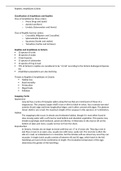Class notes
Birds, Amphibians, and Reptiles
- Institution
- Durham College ( )
VERY detailed notes on birds, amphibians, and reptiles found in Ontario. Goes into detail regarding identification, requirements, behaviour, reproduction, habitat, and much more.
[Show more]



